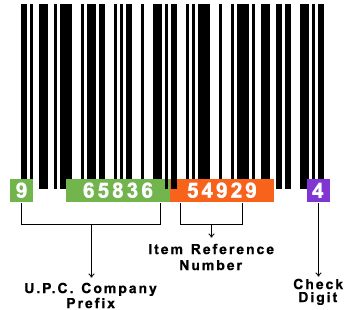How to Set up UPC Barcodes on your Products
Universal product codes, which are 12-digit numbers issued by the nonprofit organization Global Standard 1 (GS1), are a standardized way to track inventory and identify sellers based on location. When a sale takes place, the barcode is scanned together with the UPC under it.
Small business owners with a unique product now have more access to sales opportunities than ever thanks to the growth of e-commerce. If business owners want to fully benefit from the global market, they must make sure their products have authentic identification numbers that are then encoded into a UPC (Universal Product Code) barcode.
Why you Should get UPC codes?
Every product sold by retailers, wholesalers, and online marketplaces must have a unique UPC. You will need one of these universal, standard codes if you want to distribute and sell your products. When an item is scanned at checkout, UPC are designed to make it simple to identify product features like the brand name, item, size, and color. The main reason they were created is to facilitate speeding up the checkout process at grocery stores. Universal Product Code is useful for tracking inventory inside a store or warehouse.
Whether you are selling online or in a physical store, by accurately identifying your product with a barcode, you can:
Parts of UPC:

All of the company's products have a six-digit UPC prefix that is the first six digits of the manufacturer's identification number that GS1 assigns. The manufacturer of the item is identified by that number. The item number is the next five digits of the UPC. It is actually a reference to the product itself.
Within each company, there is a person responsible for issuing product numbers to ensure that the number isn’t used more than once and that old numbers referring to discontinued products are phased out. Many consumer products are available in various varieties depending on factors like size, flavor, or color. Every variant needs a unique item number.
What is the difference between a UPC code and an inventory barcode?
❖ A UPC code (Universal Product Code) is a specific type of inventory barcode used to identify and track consumer products in retail settings. UPC codes are standardized and consist of a 12-digit number, which is used to represent the product's unique identifier, manufacturer and other relevant details.
❖ On the other hand, an inventory barcode is a broader term that refers to any barcode used for tracking inventory or assets within a business or organization. Inventory barcodes can take various forms, such as Code 39, Code 128, or 2D barcodes. They may also contain different information, such as stock numbers, serial numbers, or location information.
❖ While UPC codes are designed for use in retail settings, inventory barcodes can be used in a range of industries and applications beyond retail, such as warehousing, manufacturing, healthcare, and more.
How to Get your Unique UPC Codes?
-
Join GS1 US and apply for your GS1 company prefix:
GS1 is the only authorized manufacturer of UPC codes. U.S. companies have access to unique GTINs as well as global e-commerce and supply chain standards.
You will apply for membership to obtain your company prefix, which is a unique set of numbers that identifies your company as the manufacturer of your product's supply chain. Your membership fee and the number of digits in your company prefix will depend on the number of UPCs you need.
To apply for membership and your company prefix, complete the GS1 US online application. Before making an online payment, you must enter your company's contact information and prefix pricing plan.
-
Choose a barcode design and determine how to display the barcode:
Vertical black stripes on a white background represent standard barcodes, but you can also choose blue stripes on a yellow or red background. Select the color scheme that you prefer and that works best for your products.
You can order digital barcodes that can be incorporated into the packaging or label design if you haven't yet printed the labels for your products. The digital barcode needs to be placed on the packaging in a flat, unwrinkled area for easy scanning. Additionally, you should confirm the size you require because changing the barcode's size can interfere with scanning. Typically, digital barcodes are positioned in the lower right corner of the packaging's back.
-
Test the printed barcodes
You should test the printed barcodes to ensure they will scan once you have ordered your barcodes and added them to your packaging. For barcode verification, you have two choices: you can pay a certified service to do it for you, or you can buy your own equipment from GS1.
Benefits of UPC Barcodes

Improve Inventory Control
Barcodes greatly facilitate accurate tracking, which lowers inventory levels. Business will ultimately have lower overhead as a result of this. They assist in tracking equipment's exact location, saving time spent looking for it.

Cost-effective
Barcode creation and printing are both inexpensive processes. No matter what they are used for or where they are attached, they are typically only few pennies in price. It's easily customizable & come in a variety of materials & finishes.
Eliminate Human Error
Barcodes decrease the possibility of human error occurring. Errors are significantly more likely to occur when data is entered manually. However, the existence of UPC barcodes on product labels significantly reduces human error.

Enhance Decision Making
UPC are useful for encouraging better decision-making. They enable business managers to make informed decisions because they provide data quickly & accurately. Better decision-making results in time and cost savings.